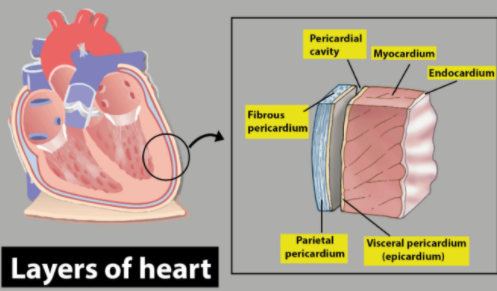
The wall of the human heart is thick, due to the presence of
(a) Inner layer (endocardium)
(b) The middle layer (myocardium)
(c) Outermost layer (pericardium)
(d) Outer layer (epicardium)
Answer
480k+ views
Hint: One of the three types of vertebrate muscles is the cardiac muscle, with the other two being skeletal and smooth muscles. It occurs as a dense layer of individual cardiomyocytes (cardiomyocytes) of heart muscle cells, thus making the heart wall thickness.
Complete answer:
The bulk of the heart comprises cardiac muscle tissue or myocardium. The heart wall is a three-layered structure sandwiched between the inner endocardium and the outer epicardium (also known as the visceral pericardium) with a thick layer of the myocardium. Thus, the wall of the human heart is thick, due to the presence of the middle layer (myocardium).
The cardiac muscle is an involuntary, striated muscle that is the dominant tissue of the heart's walls. It consists of individual heart muscle cells (cardiomyocytes) joined together by collagen fibers and other substances that form the extracellular matrix, encased by intercalated discs.
Additional Information: The cardiac chambers are lined by the inner endocardium, covering the cardiac valves, and joining the endothelium that lines the blood vessels that link to the heart.
The epicardium that forms part of the pericardium, the sac that covers, protects, and lubricates the nucleus, is on the outer side of the myocardium.
Heart muscle contraction takes a large amount of energy, and thus requires a steady supply of blood to provide oxygen and nutrients. The coronary arteries bring blood to the myocardium. These arise from the root of the aortic and lie on the heart's outer or epicardial surface. The coronary veins then drain blood into the right atrium.
Myocardial infarction or heart attack occurs if a coronary artery unexpectedly becomes very narrowed or entirely blocked, interrupting or significantly reducing blood flow through the vessel.
So, the answer is, “middle layer (myocardium).”
Note: -There are several sheets of cardiac muscle cells or cardiomyocytes inside the myocardium.
-The muscle sheets that wrap nearest to the endocardium around the left ventricle are aligned perpendicular to those closest to the epicardium.
- Ischaemic heart disease, in which blood flow to the heart is decreased, is the most common condition affecting cardiac muscle.
-Despite a regular blood supply, the heart muscle may also become affected. In a condition called myocarditis (myocardium inflammation), the heart muscle can become inflamed.

Complete answer:
The bulk of the heart comprises cardiac muscle tissue or myocardium. The heart wall is a three-layered structure sandwiched between the inner endocardium and the outer epicardium (also known as the visceral pericardium) with a thick layer of the myocardium. Thus, the wall of the human heart is thick, due to the presence of the middle layer (myocardium).
The cardiac muscle is an involuntary, striated muscle that is the dominant tissue of the heart's walls. It consists of individual heart muscle cells (cardiomyocytes) joined together by collagen fibers and other substances that form the extracellular matrix, encased by intercalated discs.
Additional Information: The cardiac chambers are lined by the inner endocardium, covering the cardiac valves, and joining the endothelium that lines the blood vessels that link to the heart.
The epicardium that forms part of the pericardium, the sac that covers, protects, and lubricates the nucleus, is on the outer side of the myocardium.
Heart muscle contraction takes a large amount of energy, and thus requires a steady supply of blood to provide oxygen and nutrients. The coronary arteries bring blood to the myocardium. These arise from the root of the aortic and lie on the heart's outer or epicardial surface. The coronary veins then drain blood into the right atrium.
Myocardial infarction or heart attack occurs if a coronary artery unexpectedly becomes very narrowed or entirely blocked, interrupting or significantly reducing blood flow through the vessel.
So, the answer is, “middle layer (myocardium).”
Note: -There are several sheets of cardiac muscle cells or cardiomyocytes inside the myocardium.
-The muscle sheets that wrap nearest to the endocardium around the left ventricle are aligned perpendicular to those closest to the epicardium.
- Ischaemic heart disease, in which blood flow to the heart is decreased, is the most common condition affecting cardiac muscle.
-Despite a regular blood supply, the heart muscle may also become affected. In a condition called myocarditis (myocardium inflammation), the heart muscle can become inflamed.

Recently Updated Pages
The correct geometry and hybridization for XeF4 are class 11 chemistry CBSE

Water softening by Clarks process uses ACalcium bicarbonate class 11 chemistry CBSE

With reference to graphite and diamond which of the class 11 chemistry CBSE

A certain household has consumed 250 units of energy class 11 physics CBSE

The lightest metal known is A beryllium B lithium C class 11 chemistry CBSE

What is the formula mass of the iodine molecule class 11 chemistry CBSE

Trending doubts
State the laws of reflection of light

One Metric ton is equal to kg A 10000 B 1000 C 100 class 11 physics CBSE

Difference Between Prokaryotic Cells and Eukaryotic Cells

How do I convert ms to kmh Give an example class 11 physics CBSE

Describe the effects of the Second World War class 11 social science CBSE

Which of the following methods is suitable for preventing class 11 chemistry CBSE




